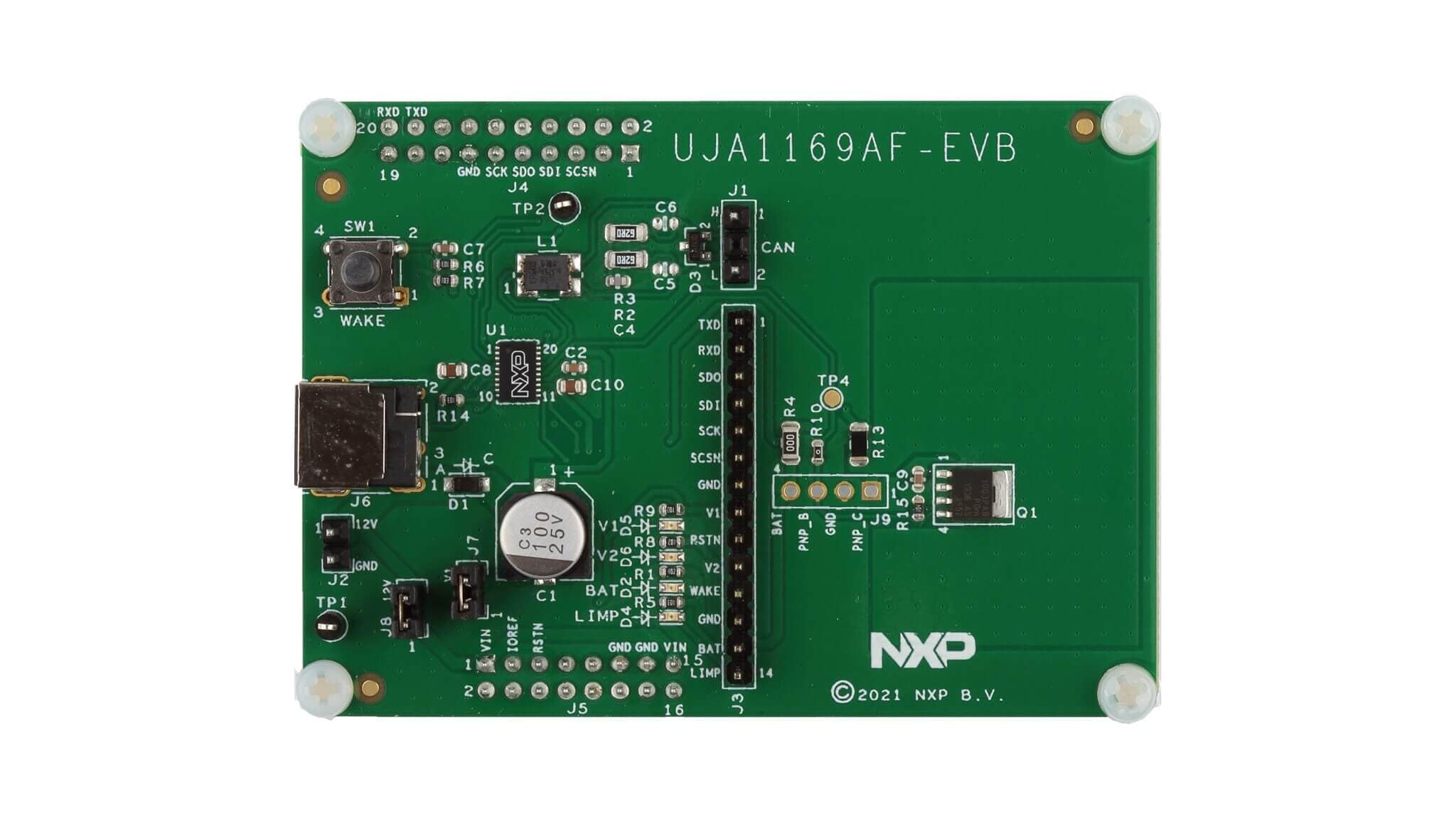Getting Started with the UJA1169Ax-EVB Evaluation Boards
Contents of this document
-
Out of the Box
-
Get Hardware
-
Configure Hardware
Sign in to save your progress. Don't have an account? Create one.

Purchase your UJA1169A Evaluation Boards
1. Out of the Box
The NXP analog product development boards provide an easy-to-use platform for evaluating NXP products. The boards support a range of analog, mixed-signal and power solutions. They incorporate monolithic integrated circuits and system-in-package devices that use proven high-volume technology. NXP products offer longer battery life, a smaller form factor, reduced component counts, lower cost and improved performance in powering state-of-the-art systems.
This page will guide you through the process of setting up and using the UJA1169AF-EVB, UJA1169AXF-EVB and UJA1169AF3-EVB evaluation boards.
1.1 Kit Content/Packing List
The kit contents include:
- Assembled and tested evaluation board in an antistatic bag
2. Get Hardware
2.1 Board Description
The UJA1169A evaluation boards are designed to facilitate the testing and evaluation of UJA1169A product features in a variety of microcontroller IO interface environments. All MCU interface signals can be accessed in two ways: at a header row on the top side and also at header rows on the bottom side that can be plugged directly into many NXP MCU evaluation boards.
The UJA1169A evaluation boards are designed to be compatible with the S32K1xx evaluation board series from NXP and to support the use of standard software development tools and drivers.
The UJA1169A evaluation board family consists of three variant boards as detailed in Table 1. The entire UJA1169A product family can be evaluated using these three boards and not just the onboard devices. For example, the UJA1169AF-EVB board (with a UJA1169ATK/F device) can be used to evaluate the UJA1169ATK by setting bit CPNC to 0 in the CAN control register. In the same way, the UJA1169ATK/X and UJA1169ATK/3 devices can be evaluated using the UJA1169AXF-EVB and UJA1169AF3-EVB boards, respectively.
| Evaluation board | On-board device | Modes | Supplies | Host interface | Additional features | Package | ||||||||||||
|---|---|---|---|---|---|---|---|---|---|---|---|---|---|---|---|---|---|---|
Normal + Standby |
Sleep |
Reset |
V1: 5 V, μC only |
V1: 5 V, μC, CAN |
V1: 3.3 V, µC only |
V2: 5 V, CAN |
VEXT: 5 V |
SPI |
RSTN: reset pin |
Watchdog |
Local WAKE pin |
Limp pin |
NVM |
CAN PN |
CAN FD passive |
HVSON20 |
||
| UJA1169AF-EVB | UJA1169ATK/F | |||||||||||||||||
| UJA1169AXF-EVB | UJA11692ATK/X/F | |||||||||||||||||
| UJA1169AF3-EVB | UJA1169ATK/F/3 | |||||||||||||||||
2.2 Kit Featured Components
Top and bottom views of the UJA1169AXF-EVB board are illustrated in Figure 1. Unless otherwise stated, the information in this section applies to all UJA1169A evaluation boards. Board dimensions are 58.5 mm × 81.1 mm. Only components needed to support basic UJA1169A functionality are included. All boards contain circuitry for reverse polarity protected battery supply, status LEDs for BAT, V1, V2/VEXT and LIMP signals, external PNP transistor for thermal management, local wake-up and CAN bus termination. The boards also provide several header rows (2.54 mm pitch) for connecting MCU interface and application signals. The headers on the bottom are compatible with the Arduino Uno pinout order, allowing the board to be connected directly to a variety of NXP MCU evaluation boards.

3. Configure Hardware
3.1 Connecting the UJA1169Ax-EVB into a CAN Network
The following conditions must be met before powering up the system with a 12 V supply.
- Connect all boards in the ECU to a common GND
-
Connect SPI pins to the MCU SPI controller:
- SDO (
J3-03,J4-09) → MISO - SDI (
J3-04,J4-07) → MOSI - SCK (
J3-05,J4-11) → SCK - SCSN (
J3-06,J4-05) → CS
- SDO (
- Connect TXD/RXD (
J3-01/J3-02,J4-18/J4-20) pins to the MCU CAN controller TXD/RXD pins - Connect RSTN (
J3-09/J5-05) to the MCU CAN controller reset pin - Connect CANH and CANL (
J1-01/J1-02) to the CAN bus twisted pair cables - Connect V1 (
J3-08,J5-03) to the MCU supply unit - For the UJA1169AXF-EVB, connect VEXT (
J3-10) to the peripheral loads that need a 5.0 V supply (optional)
Once the above steps have been completed, the ECU/EVB can be powered up using an external battery supply. The UJA1169A starts up in Forced Normal mode (if MTP is not configured) or Standby mode (if MTP configured), awaiting commands from the MCU via the SPI interface.
An example showing how to connect the UJA1169AXF-EVB between an MCU and the CAN bus is shown in the following figure.

Design Resources
Board Documents
Additional Resources
In addition to our UJA1169ATK: Mini High-Speed CAN System Basis Chip, you may also want to visit:
Product Pages:
- UJA1167ATK: Mini High-Speed CAN System Basis Chip with Standby/Sleep Mode and Watchdog
- UJA1168ATK: Mini High-Speed CAN System Basis Chip for Partial Networking